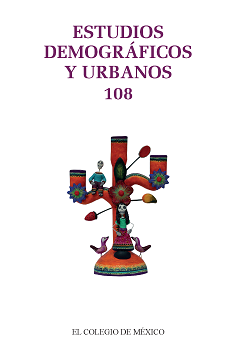The Sustainable Society Index (SSI) in América: Analysis from a dynamic Biplot perspective
Published 2021-09-17
Keywords
- multivariate analysis,
- sustainability,
- Biplot,
- sustainable development indicators,
- multivariate statistics
How to Cite
-
Abstract955
-
PDF (español)461
-
En línea (español)53
Downloads
Copyright (c) 2021 Estudios Demográficos y Urbanos

This work is licensed under a Creative Commons Attribution-NonCommercial-NoDerivatives 4.0 International License.
Metrics
Abstract
This study presents a dynamic Biplot analysis of the Sustainable Society Index applied to the American continent. The main results when analyzing the trajectories of the variables in general are short and tend to improve. Two groups were observed: the first joins countries well positioned against the variables “basic needs” and “personal and social development” (North America), and the second puts together countries with irregular behavior trajectories, with little stability and with a tendency to fall in the last periods in analysis (Central, South America and the Caribbean). The Dynamic Biplot method proves to be a new approach to three-way data processing and provides results that are easy to represent and interpret.
References
- Brundtland, G. H. (1987). Report of the World Commission on Environment and Development: Our common future. United Nations. https://sswm.info/sites/default/files/reference_attachments/UN%20WCED%201987%20Brundtland%20Report.pdf
- Cracolici, M. F., Cuffaro, M. y Nijkamp, P. (2010). The measurement of economic, social and environmental performance of countries: A novel approach. Social Indicators Research, 95(2), 339-356. https://www.ncbi.nlm.nih.gov/pubmed/19966915 DOI: https://doi.org/10.1007/s11205-009-9464-3
- Crepaz, M. (1995). Explaining national variations of air pollution levels: Political institutions and their impact on environmental policy-making. Journal Environmental Politics, 4(3), 391-414. https://www.tandfonline.com/doi/abs/10.1080/09644019508414213 DOI: https://doi.org/10.1080/09644019508414213
- Egido, J. (2017). dynBiplotGUI: Full interactive GUI for Dynamic Biplot in R. R package version 1.1.5. https://CRAN.R-project.org/package=dynBiplotGUI
- Egido, J. y Galindo, P. (2015). Dynamic Biplot. Evolution of the economic freedom in the European Union. British Journal of Applied Science and Technology. 11(3), 1-13. http://www.journalrepository.org/media/journals/BJAST_5/2015/Aug/Egido1132015BJAST20289.pdf DOI: https://doi.org/10.9734/BJAST/2015/20289
- Gabriel, K. (1971). The Biplot graphic display of matrices with applications to principal components analysis. Biometrika, 58(3), 453-467. https://www.jstor.org/stable/2334381?seq=1#page_scan_tab_contents DOI: https://doi.org/10.1093/biomet/58.3.453
- Galindo, M. (1986). Una alternativa de representación simultánea: HJ-Biplot. Questiió, Quaderns d´Estadística, Sistemes, Informatica i Investigació Operativa, 10(1), 13-23. https://dialnet.unirioja.es/servlet/articulo?codigo=2360880
- Gallego-Álvarez, I., Galindo-Villardón, M. P. y Rodríguez-Rosa, M. (2015). Analysis of the sustainable society index worldwide: A study from the Biplot perspective. Social Indicators Research, 120(1), 29-65. https://link.springer.com/article/10.1007/s11205-014-0579-9 DOI: https://doi.org/10.1007/s11205-014-0579-9
- Giles, D. y Feng, H. (2005). Output and well-being industrialized nations in the second half of the 20th century: Testing for convergence using fuzzy clustering analysis. Structural Change and Economic Dynamics, 16(2), 285-308. https://www.sciencedirect.com/science/article/abs/pii/S0954349X0400058X DOI: https://doi.org/10.1016/j.strueco.2004.08.001
- Hausmann, R., Rodrik, D. y Velasco, A. (2008). Growth diagnostics. En N. Serra y J. E. Stiglitz (eds.), The Washington consensus reconsidered. Towards a new global governance (pp. 324-355). Londres: Oxford University Press. DOI: https://doi.org/10.1093/acprof:oso/9780199534081.003.0015
- Jahn, D. (1998). Environmental performance and policy regimes: Explaining variations in 18 OECD-countries. Policy Sciences, 31(2), 107-131. https://link.springer.com/article/10.1023/A:1004385005999 DOI: https://doi.org/10.1023/A:1004385005999
- Neumayer, E. (2003). Are left-wing party strength and corporatism good for the environment? Evidence from panel analysis of air pollution in OCDE countries. Ecological Economics, 45(2), 203-220. https://www.sciencedirect.com/science/article/pii/S0921800903000120 DOI: https://doi.org/10.1016/S0921-8009(03)00012-0
- R Core Team (2018). R: A language and environment for statistical computing. R Foundation for Statistical Computing. Viena, Austria. https://www.gbif.org/es/tool/81287/r-a-language-and-environment-for-statistical-computing
- Rodrik, D. (2007). One economics, many recipes: Globalizations, institutions and economic growth. Princeton, New Jersey: Princeton University Press. DOI: https://doi.org/10.1515/9781400829354
- Scruggs, L. (1999). Institutions and environmental performance in seventeen western democracies. British Journal of Political Science, 29(1), 1-13. https://ideas.repec.org/a/cup/bjposi/v29y1999i01p1-31_00.html DOI: https://doi.org/10.1017/S0007123499000010
- Scruggs, L. (2001). Is there really a link between neo-corporatism and environmental performance? Updated evidence and new data for the 1980s and 1990s. British Journal of Political Science, 31(4), 686-692. https://www.jstor.org/stable/3593298?seq=1#page_scan_tab_contents DOI: https://doi.org/10.1017/S0007123401220262
- Scruggs, L. (2003). Sustaining abundance. Environmental performance in industrial democracies. Cambridge: Cambridge University Press. https://doi.org/10.1017/CBO9780511615689 DOI: https://doi.org/10.1017/CBO9780511615689
- Van de Kerk, G. y Manuel, A. (2014). Sustainable Society Index-SSI 2014. Países Bajos: Sustainable Society Foundation. https://ssi.wi.th-koeln.de/documents/ssfindex/ssi-2014.pdf
- World Bank. (2017-2018). World Bank list of economies. www.worldbank.org


